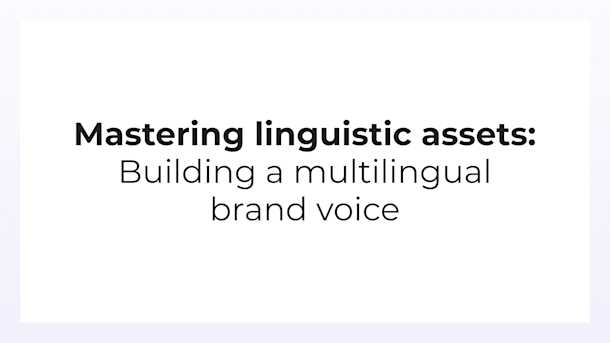In today’s dynamic translation landscape, linguistic assets are more crucial than ever for companies focused on maintaining their brand's unique voice across languages. Smartling’s latest webinar, featuring insights from R&D leaders Olga Beregovaya and Jason Rauchwerk, explored best practices for creating, optimizing, and managing linguistic assets—such as glossaries and style guides—to ensure consistent brand voice in every language.
The Growing Importance of Linguistic Assets
As brands expand globally, linguistic assets like translation memory, glossaries, and style guides have become essential tools for maintaining consistency across both human and AI-powered translations. These assets ensure that your brand’s message remains clear and consistent, regardless of the language in which it’s conveyed.
However, the value of these assets hinges on their relevance and accuracy. Olga and Jason emphasized the necessity of regular reviews and updates to glossaries, style guides, and translation memory data. By continuously deprecating outdated translations and refining terminology, you can align your linguistic assets with your evolving brand messaging. Neglecting these updates can lead to inconsistent translations, mistranslations, and errors that compromise brand integrity.
“One healthy habit is to deprecate what's not relevant anymore, and you can do it based on the timestamp,” Olga suggested, “If it's been sitting there forever and not used, maybe something is off. Maybe it's time you deprecate it.”
Olga particularly highlighted the importance of style guides, not only for maintaining brand voice but also for reflecting locale-specific conventions and providing guidelines for custom machine translation engines. Partnering with a company like Smartling can help you manage and optimize these linguistic assets, ensuring they evolve alongside translation technologies.
Transforming Linguistic Assets with AI
Artificial Intelligence (AI) has brought a new dimension to the translation industry, especially with the rise of Large Language Models (LLMs). Jason discussed how LLMs streamline complex tasks, such as maintaining natural sentence structures while incorporating glossary terms, thereby preserving fluency in translations. He noted that LLMs equipped with retrieval augmented generation (RAG) can maintain a consistent style even in large-scale translations.
The evolution of linguistic assets, particularly style guides, from being tools for human linguists to becoming data inputs for customizing machine translation engines marks a significant milestone in translation technology. Businesses can now harness AI for term harvesting to build and refine their glossaries, leading to enhanced machine translation output.
Additionally, AI can further tailor translation outputs with prompts for informal versus formal translations, potentially enabling transcreation that is on-brand and stylistically accurate.
Building Your Linguistic Assets
To build healthy linguistic assets, solidifying your glossary is the first place to start. Capturing your brand’s voice is key when creating a glossary, and this should be complemented by comprehensive style guides designed for both human translators and AI systems.
Once you establish a glossary of brand terms, you can build translation memory and gradually expand your glossary through term harvesting. As your translation memory grows with each project, it provides more material for term harvesting, enabling the continuous development of your terminology database. AI-designed aligners can also assist in creating bilingual glossaries, further enriching your linguistic assets.
By leveraging the strengths of AI and well-maintained linguistic assets, companies can elevate their translation capabilities beyond traditional methods, staying ahead in today’s fast-paced digital landscape.
Ready to master your linguistic assets? Watch the full webinar here.








